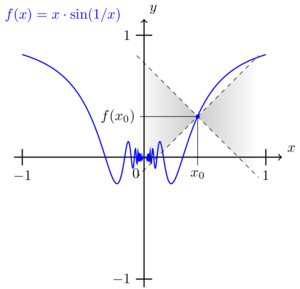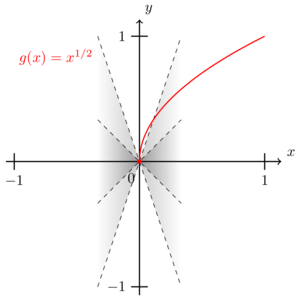Exercises: Continuity – Serlo
Lipschitz continuous functions are uniformly continuous
[Bearbeiten]Exercise
Let be Lipschitz continuous with Lipschitz constant . That is
for all . Prove that is uniformly continuous.
How to get to the proof?
We need to show that for all , there is a , such that for all with there is . By our assumption, we have
In order for to hold, it suffices to have . We can reach this by taking .
Proof
Let be arbitrary. We choose . Then, for all with :
Continuity at the origin
[Bearbeiten]Exercise
Prove that the following function is continuous at the origin :
with a real number
How to get to the proof?
In order to establish continuity at the origin , we make use of the epsilon-delta criterion. That means, for all we have to find a such that the inequality holds at all with . The question now is how to find a suitable for any given . To answer this question, we take a look at the function around :
Since at , there is
This inequality also holds at , since . Visually, the inequality above means that the graph of the function fits inside the "double wedge" given by , where tells us, how much the wedge is "stretched" in -direction. So if we choose , then at any with , there is
Which we can use to carry through the proof (see below).
Note: We can also "move the double wedge" to any when investigating continuity at . If the graph fits inside the "moved double wedge" , then for any , there is
So any function fitting in such a double wedge is continuous. The converse does not hold true. There are functions which do not fit in any double wedge around but are continuous at . An example is the square root function around .
-
The function is continuous at .
-
The function is continuous at any .
-
The function is not Lipschitz-continuous at
Proof
Let . We choose . Let be any real number with . Then:
This shows that is continuous at .
Extreme value theorem
[Bearbeiten]Exercise (Maximum and minimum of a function)
Prove that the function defined on attains a maximum, but not a minimum.
Solution (Maximum and minimum of a function)
Proof step: attains a maximum
The function is continuous on , since it is composed by continuous functions and the denominator is strictly positive (). The enumerator is also strictly positive, so for , , and
That means, there is an with for all . The extreme value theorem implies that attains a maximum on . One may even show that the maximum is even global. However, computing the maximum explicitly would require us to solve , which is quite a computational effort and can be even harder for other functions . The extreme value theorem just allowed us to quickly show that there is a maximum - and saved us from the tedious solution of .
Proof step: does not attain a minimum
There is on . And indeed, approaches 0 (see the previous proof step). But it does not attain 0. Since and by continuity, there can not be a minimum (if there was an attained minimum , then by , there would by for some , which is a contradiction ).
Exercise (How often is a value attained #1)
- Show that there is no continuous function , which attains each of its function values exactly twice.
- Is there a continuous function , which attains each of its function values exactly three times?
Exercise (How often is a value attained #2)
Let with . Show: There is no continuous function , which attains each of its function values exactly times.
Intermediate value theorem and zeros
[Bearbeiten]Exercise (Zero of a function)
Prove that the function
has exactly one zero inside the interval .
Solution (Zero of a function)
Proof step: has at least one zero
is continuous as it is composed by the continuous functions and . In addition,
and
By means of the intermediate value theorem, there must be an with .
Proof step: has exactly one zero
is strictly monotonously increasing on . The function is also monotonously increasing on , so is decreasing and again increasing. Hence there can be only one zero with , since a function with two zeros is never strictly monotonously increasing (it would either have to stay constant or go "down again" between and ).
Exercise (Solution of an equation)
Let with . Prove that the equation
Has at least three solutions.
Solution (Solution of an equation)
It is a powerful trick in mathematics, to transform the problem of finding solutions to as zeros of an auxiliary function (if , then and vice versa). In our case, the continuous auxiliary function is
When approaching and , this function goes to
and
Therefore, there must be two arguments with and ( is close to and close to ). By the intermediate value theorem, there must hence be a zero with . This zero is one solution of the above equation.
The same argument works between and . Since and , we can use the intermediate value theorem and get a zero with .This is the second solution we have been looking for.
The third solution follows by a similar argument. There is and . So the intermediate value theorem renders a with . The equation has therefore at least three solutions.
Exercise (Solution of an equation)
Let be continuous with . Prove that there is a with .
Solution (Solution of an equation)
We consider the following auxiliary function:
Finding a with now amounts to finding a zero of . Since is continuous, so is . In addition, at the endpoints of the interval, there is
and
Fall 1:
This means , or equivalently
So we have found a solution to .
Fall 2:
We will first consider the case . Since , there is . The intermediate value theorem now yields a with
This is a zero of and hence a desired solution for . The other case can be treated using exactly the same arguments.
So for any choice of , there is a with .
Exercise (Existence of exactly one zero)
Let be a natural number. We define the function . Prove that has exactly one positive zero.
Solution (Existence of exactly one zero)
We need to show two things: At first, we need to show that a zero exists inside the interval . Second, we need to assure that there is indeed only one such zero.
The function is a polynomial function and hence continuous. At the beginning of the interval , there is i.e. the graph of the function runs below the -axis. At infinity, there is , meaning that for large , the graph runs above the -axis. As is continuous, we can apply the intermediate value theorem and get a zero .
Now we need to show that there is at most one zero. Both and are strictly monotonously increasing functions for . So we may assume that is also strictly monotonous, there. We can prove this assumption be taking the first derivative:
For there is: .
One may show with a bit of effort that differentiable functions with positive derivative are strictly monotonous in the sense that for . If there were two zeros , we would have although there is . This would contradict being monotonous and in hence excluded. Therefore, can have at most one zero (as all strictly monotonous functions).
Note: We could also prove that has at most one zero, only using that is differentiable with :
Assume that, the function would have two zeros with . Since the function is differentiable and , we may use Rolle's theorem and get that some exists wit . But this is a contradiction to the first derivative of being strictly positive . So this is a second way to exclude the existence of two zeros.
Continuity of the inverse function
[Bearbeiten]Exercise (Continuity of the inverse function 1)
Let be defined by
- Prove that is continuous, strictly monotonous and injective.
- Prove that ist surjectiive (so it is a 1-to-1-map from to an inverse function exists).
- Why is the inverse function continuous, monotonously increasing and bijective? Explicitly determine .
Solution (Continuity of the inverse function 1)
Part 1: is continuous on since it is the quotient of the continuous polynomials and . Note that for all .
Let with . Then, strict monotony holds:
Therefore, is also injective.
Part 2: The function runs towards infinity at the end points of the open interval as follows:
Since is continuous, the intermediate value theorem ensures that for each there is a mapped onto it: . Therefore, is also surjective: .
Part 3: Since is bijective, the inverse map exists and is bijective, as well:
The theorem about continuity of the inverse function tells us that is continuous and strictly monotonously increasing. Now, let us compute . That means, we need to bring into the form - i.e. we need to get standing alone on the left side of the equation:
Fall 1:
Fall 2:
We can use the quadratic solution formula in order to solve for :
Since for , the only reasonable solution is . Putting all together, the full definition for the inverse function reads
Hint
The distinction of two cases above is not very convenient. We can avoid it using a little trick: In case enumerator and denominator of can be multiplied by a factor of :
Plugging in , we get that is described correctly. So we can use the definition above for all and avoid the case distinction.
Exercise (Continuity of the inverse function 2)
Let
- Prove that is injective.
- Determine the range of all attained values.
- Why is the inverse function continuous?
Solution (Continuity of the inverse function 2)
Part 1:
is continuous, as it is composed by the continuous functions , , and on .
The logarithm is strictly monotonously increasing (and its inverse is decreasing): for with , there is:
Now, for . Since in addition, is strictly monotonously decreasing on , we have
So the -term is also strictly monotonously increasing and so is :
Therefore, is also injective.
Part 2:
At the ends of the domain of definition, there is
and
this implies
is continuous on the interval . Hence, we can use a corollary of the intermediate value theorem, and get that is again an interval. Since is strictly monotonously increasing and , we can conclude
Part 3:
Since is an interval and in bijective, we can use the theorem about continuity of the inverse function. I tells us that
is indeed continuous.












































![{\displaystyle {\begin{aligned}\left|f(x)-f(0)\right|&=\left|x\cdot \sin \left({\frac {1}{x}}\right)-0\right|\\[0.3em]&=\left|x\cdot \sin \left({\frac {1}{x}}\right)\right|\\[0.3em]&\quad {\color {Gray}\left\downarrow \ |\sin(\cdot )|\in [0,1]\right.}\\[0.3em]&\leq |x|\\[0.3em]&\quad {\color {Gray}\left\downarrow \ {\text{by assumption }}|x|<\delta \right.}\\[0.3em]&<\delta \\[0.3em]&\quad {\color {Gray}\left\downarrow \ {\text{by choice }}\delta =\epsilon \right.}\\[0.3em]&=\epsilon \\[0.3em]\end{aligned}}}](https://wikimedia.org/api/rest_v1/media/math/render/svg/0815bfbf1717b17fbed1ad1402fb922a4cf285dd)










![{\displaystyle [1,x_{0}]}](https://wikimedia.org/api/rest_v1/media/math/render/svg/ffcdcb26a12ac1e3b6ca0a109ec4f018652fbf40)








![{\displaystyle f:[0,1]\to \mathbb {R} }](https://wikimedia.org/api/rest_v1/media/math/render/svg/2de6d0d4c98d4ca7ad937c772dc3e3e914b062f5)


![{\displaystyle [0,{\tfrac {\pi }{2}}]}](https://wikimedia.org/api/rest_v1/media/math/render/svg/c406038f382a4125601d91fe4ee36262cbb60fef)




![{\displaystyle {\tilde {x}}\in [0,{\tfrac {\pi }{2}}]}](https://wikimedia.org/api/rest_v1/media/math/render/svg/3f869afea7b1f1945f561443b546b3d575f5d844)























![{\displaystyle {\tilde {x}}\in [x_{1},x_{2}]\subset (a,b)}](https://wikimedia.org/api/rest_v1/media/math/render/svg/5a57df501598c92cf689fe28f87d2c94929d1fe6)












![{\displaystyle c\in [0,1]}](https://wikimedia.org/api/rest_v1/media/math/render/svg/02b2796dc5e3cb6527d1ac6e766dc1da2ef1e120)

![{\displaystyle h:[0,{\tfrac {1}{2}}]\to \mathbb {R} ,\ h(c)=f(x+{\tfrac {1}{2}})-f(x)}](https://wikimedia.org/api/rest_v1/media/math/render/svg/ccbbf8f82c4ae0a8b4e72b5e736ec98dbb660658)










![{\displaystyle c\in [0,{\tfrac {1}{2}}]\subset [0,1]}](https://wikimedia.org/api/rest_v1/media/math/render/svg/3307974963566ede2262855b9d0f67d2d28c07b1)






![{\displaystyle ]0;+\infty [}](https://wikimedia.org/api/rest_v1/media/math/render/svg/9a2b9afa8192cc3f8173fadddad0d1f5c499d881)


![{\displaystyle x_{1}\in ]0;+\infty [}](https://wikimedia.org/api/rest_v1/media/math/render/svg/0a24e1b870ccab8c6a2e803072884fa1fce8dc97)











![{\displaystyle x_{1},x_{2}\in ]0;+\infty [}](https://wikimedia.org/api/rest_v1/media/math/render/svg/201c1c2873cefa352f4672a5eec3005f92682d7d)

![{\displaystyle \xi \in ]x_{1};x_{2}[}](https://wikimedia.org/api/rest_v1/media/math/render/svg/01e4a47cb998db4453b1bc10276c7464d42295f3)


















![{\displaystyle f[(-1,1)]=\mathbb {R} }](https://wikimedia.org/api/rest_v1/media/math/render/svg/4299fa67bbb0b7a07a258d93c9fbbea94ce02d29)
























![{\displaystyle {\frac {1}{\ln(x+e)}}\in (0,1]}](https://wikimedia.org/api/rest_v1/media/math/render/svg/c3d3def8a9b3bfb4541f13dc034ea7e9d58f67ad)


![{\displaystyle (0,1]}](https://wikimedia.org/api/rest_v1/media/math/render/svg/7e70f9c241f9faa8e9fdda2e8b238e288807d7a4)




![{\displaystyle \lim _{x\to \infty }g(x)=\lim _{x\to \infty }[\underbrace {\ln(x+e)} _{\to \infty }-\underbrace {\cos \left({\frac {1}{\ln(x+e)}}\right)} _{\to \cos(0)=1}]=\infty }](https://wikimedia.org/api/rest_v1/media/math/render/svg/5eee71e2cf83f48c23ff3d16ea666ee30b7d9cf2)





